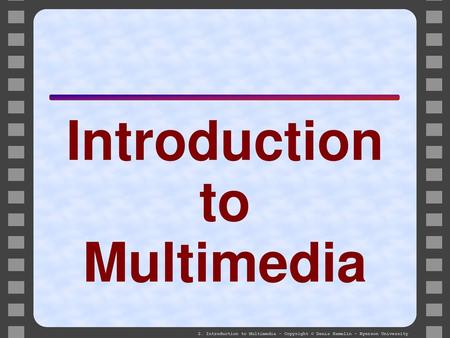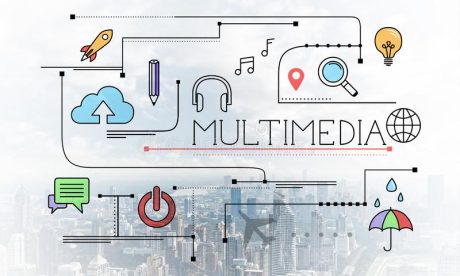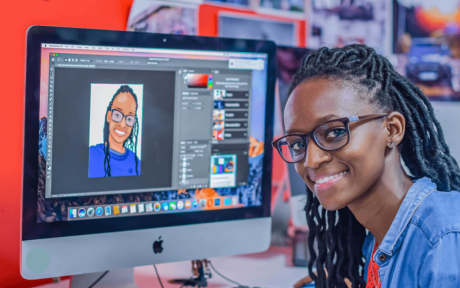100
MULTIMEDIA TECHNOLOGY PART 1 In this course, we will study the basics of the multimedia system and of the different …
TAKE THIS COURSE
150 SEATS LEFT
MULTIMEDIA TECHNOLOGY PART 1
In this course, we will study the basics of the multimedia system and of the different elements of the multimedia system. The theories of Authoring systems, its tools and development areas have also been discussed in this course. This course also considers the concept of Video Conferencing and the protocols in Multimedia such as the real time transfer protocol, session control protocol etc. It goes beyond the traditional access network processes to discuss technological developments such as Cable Television, Digital Subscriber lines, digital television etc. The overall aims of this course are to introduce you to the history and components of the Multimedia Technology. The fundamentals of Digital audio, video, images and colours are equally discussed. There are five modules in this course; each module consists of at least 4 units of topics that you are expected to complete in 2 hours. The five modules and their units are listed below. What You will Learn in this Course The overall aims and objectives of this course are to provide guidance on what you should be achieving in the course of your studies. Each unit also has its own unit objectives which state specifically what you should achieve in the corresponding unit. To evaluate your progress continuously, you are expected to refer to the overall course aims and objectives as well as the corresponding unit objectives upon the completion of each. Course Aims- The overall aims and objectives of this course will help you to:
- Develop your knowledge and understanding of the underlying concepts and theories of the Multimedia System.
- To outline and critically analyze the different elements of the Multimedia System.
- Develop your competence in understanding the concept and developing applications of Multimedia Technology.
- Provide the necessary details on how multimedia data are represented, stored, compressed and used;
- Discuss the history of Multimedia
- Give a concise definition of Multimedia
- Identify the desired features of the Multimedia System
- Explain the term “Multimedia Hardware ”
- Outline the types of Multimedia Hardware.
- Explain what the Software is
- State the significance of a software in Multimedia System
- Explain the concept of Digital Audio
- Identify the difference between a digital and analogue audio system
- Explain the principles of Video compression
- Identify ways to create digital images
- Explain the Basics of Color
- Discover the benefits and challenges of using Colors
- Define the term Authoring System
- Outline and state the features of an Asynchronous Transfer Mode(ATM)
- Describe the Routing process
- Explain the concept of Video Conferencing
- Describe the Internet Telephony Service and the Computer Telephony Integration
- Discuss the concept and features of a Digital Subscriber Lines
DOWNLOAD COURSE HERE
Course Currilcum
- MT1: UNIT 4 ATM – Multimedia Systems Technology FREE 00:40:00
- In the previous unit we examined the quality of Service and the types of services associated with it. Here, we will be looking at ATM, the Asynchronous transfer Mode in Multimedia Technology. Do make the most of your studies. 2.0 OBJECTIVES At the end of this unit, you should be able to: Identify what an ATM is State the typical features of the Asynchronous transfer Mode
- MT1: UNIT 3 MULTIMEDIA COMMUNICATIONS – Multimedia Systems Technology FREE 00:40:00
- Within a communications network, multimedia applications require interactive or distribution services. Interactive services are divided into conversational, messaging and retrieval services. This unit presents the concept of Quality of Service and explains the types of services available within the quality of service. 2.0 OBJECTIVES What you would study in this unit, would make it possible for you to: Give a concise definition of a QoS State the advantages of a Differentiated Services Identify the features of an Integrated Services
- MT1: UNIT 2 AUTHORING SYSTEM – Multimedia Systems Technology Unlimited
- In this module, we will focus on the different media Systems technology. We will equally consider the authoring system and the different authoring tools. 2.0 OBJECTIVES What you will study in this unit, would enable you: Define the term Authoring System List the Authoring Tools Identify the key role of the authoring system in the multimedia technology.
- MT1: UNIT 1 MULTIMEDIA COMPRESSION – Multimedia Systems Technology Unlimited
- Multimedia compression is a broad term that refers to the compression of any type of multimedia (i.e. combination of media and content forms), most notably graphics, audio, and video. In this unit, we shall treat the concepts of Multimedia Compression. We shall consider the different categories of compression and the similarities between them. 2.0 OBJECTIVES At the end of this unit, you should be able to: Describe the concept of Multimedia Compression Explain the differences in the different categories of Multimedia Compression Discuss the principle of video compression
- MT1: UNIT 4 COLOUR -Elements of multimedia Unlimited
- In this unit we will be learning about the basics of colour. We would also bring to light the benefits and challenges of using colour as well as the guidelines for using colours. Hope you will be able to grasp the key points. 2.0 OBJECTIVES What you would study in this unit, would enable you to: Explain the basics of Colours Discover the science of Colours Discuss the benefits and challenges of using Colour
- MT1: UNIT 3 IMAGE-Elements of multimedia Unlimited
- Now that you’ve been introduced to two elements of the multimedia system, we will now consider Images as another element of the multimedia systems. 2.0 OBJECTIVES At the end of this unit, you should be able to: Describe what a digital Image is? Identify the ways to create digital Images State the difference between an image and a digital Image List the ways to process the Digital Image.
- MT1: UNIT 2 VIDEO-Elements of multimedia Unlimited
- A still image is a spatial distribution of intensity that is constant with respect to time. Video, on the other hand, is a spatial intensity pattern that changes with time. Another common term for video is image sequence, since video can be represented by a time sequence of still images. Video has traditionally been captured, stored and transmitted in analog form. The term analog video signal refers to a one-dimensional (1-D) electrical signal of time that is obtained by sampling the video intensity pattern in the vertical and temporal coordinates and converting intensity to electrical representation. The unit will equally analyse the principles and application of video. 2.0 OBJECTIVES At the end of this unit, you should be able to: Describe the features of a Video Explain the need of a Video in the Multimedia System
- MT1: Unit 1 DIGITAL AUDIO-Elements of multimedia Unlimited
- MT1: UNIT 5 NETWORK-Introduction to Multimedia Technology Unlimited
- Networking involves connecting computes to create a for the purpose of sharing information and resources. Even though the concept is basic, a great deal of technology is required to one computer to connect and communicate with another. In this unit, you learn about the fundamental concepts that drive all networks and understand why networking is so important in an organisation. OBJECTIVES Give a concise definition a network List and discuss the different topology of network Describe the characteristics of the different network topologies Differentiate between the client server and peer-to peer styles of network
- MT1: UNIT 4 SERVER COMPUTER-Introduction to Multimedia Technology Unlimited
- In this unit, we shall focus on the definition of a computer server. We will equally consider the different types of the specialised server. 2.0 OBJECTIVES At the end of this unit, you should be able to: Identify what a Server is List and explain the different types of specialised Server. Differentiate between the different types of servers listed below.
- MT1: UNIT 3 MULTIMEDIA SOFTWARE-Introduction to Multimedia Technology Unlimited
- Computer software, or just software, is a collection of computer programs and related data that provide the instructions telling a computer what to do and how to do it. Software is, in a way invisible, and therefore not recognized as important in an electronic imaging system. Software is just as important as hardware, however, because the hardware will not function without it. The "brains" of the system, software includes the instructions, procedures, and system supervisor in an electronic form. 2.0 OBJECTIVES By the end of this unit, you should be able to: ·Explain what software is State the significance of software in the multimedia system List the functions of a Software
- MT1: UNIT 2 MULTIMEDIA HARDWARE-Introduction to Multimedia Technology Unlimited
- A multimedia system is not different from any other type of computer system except for its ability to process multimedia data. Thus, it should have features that can process audio, video, graphics and animation. In this Unit and the following, we will be considering the components (Hardware and Software) required for a multimedia system 2.0 OBJECTIVES At the end of this unit, you should be able to: Explain the term “Multimedia Hardware” Outline the different types of Multimedia Hardware Describe the difference between the types of multimedia systems
- MT1: UNIT 1 OVERVIEW OF MULTIMEDIA TECHNOLOGY-Introduction to Multimedia Technology Unlimited
- INTRODUCTION The term "multimedia" describes a new application-oriented technology that is based on the multisensory nature of humans and the evolving ability of computers to convey diverse types of information. Fundamental to this technology is the ability to manipulate digital forms of audio and video information in the realm of the computer. Multimedia requires integrating storage, communication and presentation mechanisms for diverse data types in a single technology. This unit will introduce you to the multimedia basics. It will also provide an overview of the essential aspects of multimedia. Thus, it is recommended that you go through the entire module systematically to gain some insight of the course. 2.0 OBJECTIVES At the end of this unit, you should be able to: Give a concise definition of multimedia Discuss the history of multimedia technology Identify the desired features of a multimedia System.
Related Courses
Harnessing Social Media & Multimedia Content Production
UGX 56,000Original price was: UGX 56,000.UGX 28,000Current price is: UGX 28,000. per 365 days 182EGC: EDITING AND GRAPHICS OF COMMUNICATION
UGX 600,000Original price was: UGX 600,000.UGX 500,000Current price is: UGX 500,000. 100







